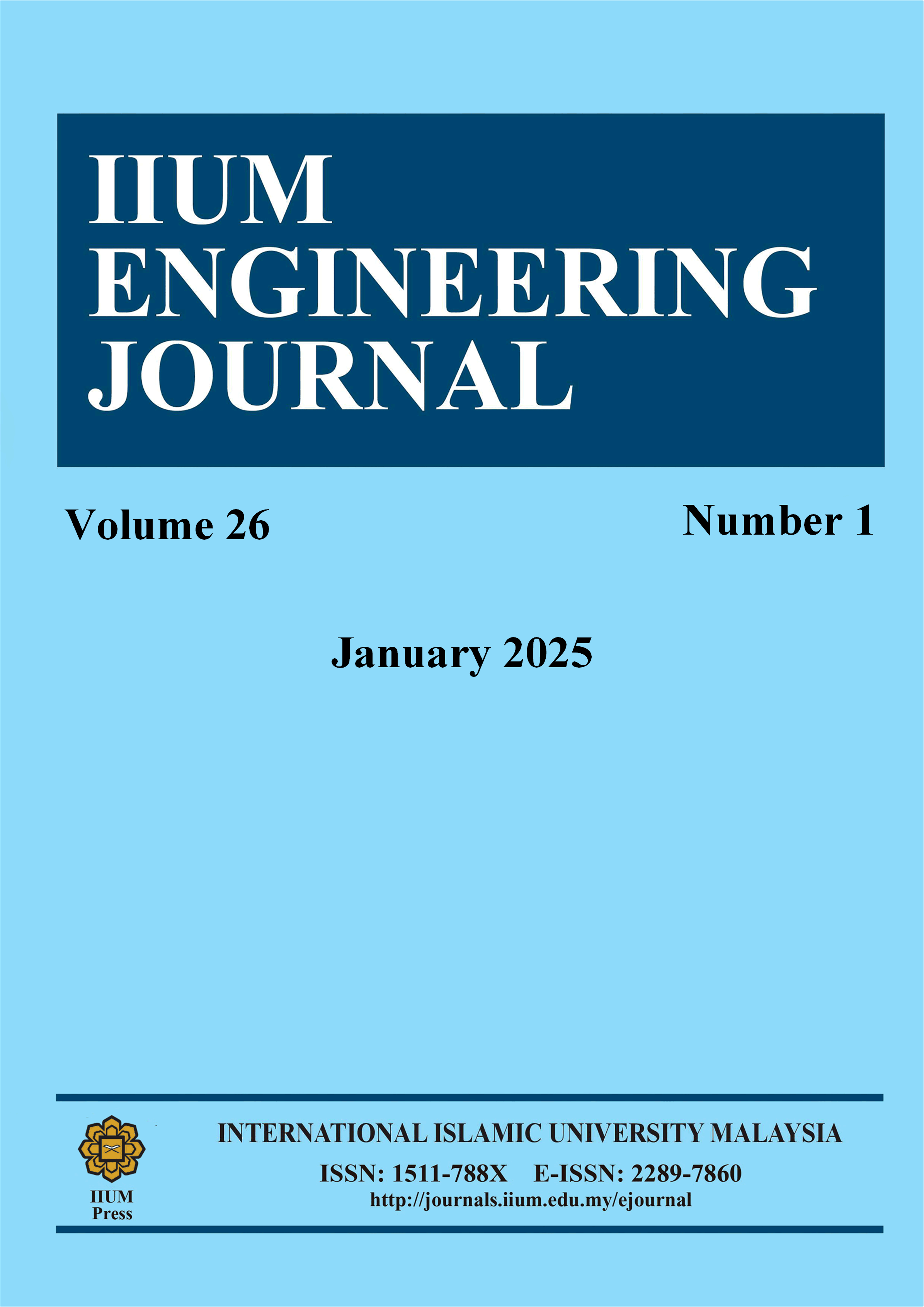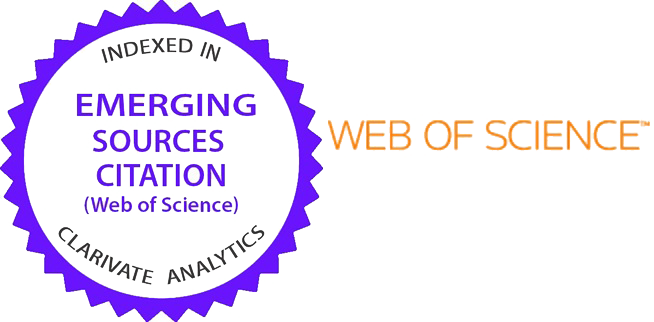Analysis of Brain Tissue Poroelastic Properties Using Multiscale Modelling
DOI:
https://doi.org/10.31436/iiumej.v26i1.3259Keywords:
Brain tissue, poroelastic properties, asymptotic expansion homogenization, multiscale modellingAbstract
Mathematical models are developed to further understand ischaemic stroke formation and achieve treatment effectiveness. The existing poroelastic model of the brain assumed the brain as a homogenized structure with uniform capillary distribution. This paper describes the use of a multiscale modeling technique known as asymptotic expansion homogenization (AEH) to derive a new poroelastic model of brain tissue. The model consists of a homogenized governing macroscale model with the effective parameters determined from the microscale cell equations. The microscale cell equations are solved on a representative volume element (RVE) comprising brain tissue embedded with a capillary. Here, the effect of capillary tortuosity and radius on the effective parameters, which are the hydraulic conductivity of the capillary and interstitial space (K and G), homogenous Biot's coefficient of the blood and interstitial space (?c? and ?t?), Young's modulus and Poisson's ratio are investigated. From the results, it is found that the percentage difference of K is 97.98% with increasing tortuosity, which suggests that K is significantly influenced by the shape of the capillary. In contrast, the percentage difference of G is only 0.25%, showing that it is unaffected by the shape of the capillary. Meanwhile, ?c? and ?t decrease and increase with increasing tortuosity, respectively. Both E and ? are not significantly affected by tortuosity, as the percentage difference for each is just 0.14% and 0.03%, respectively. In terms of capillary radius, it is found that K increases and G decreases with the increase of radius. Meanwhile, ?c? increases with increasing radius, while ?t? shows the opposite trend. The percentage differences of 18.26% and 14.55% are observed for E? and ?, respectively, implying that both parameters are significantly affected by the capillary radius. In conclusion, including capillaries in the brain model significantly affects the effective parameters. Hence, important properties of the capillary, including shape and size, should be carefully emphasized so that accurate findings can be obtained when solving the poroelastic model of the brain.
ABSTRAK:
Model matematik dibangunkan untuk mendapatkan pemahaman lanjut tentang pembentukan strok iskemia supaya keberkesanan rawatan dapat dicapai. Model poroelastik otak yang sedia ada menganggap otak sebagai struktur homogen dengan taburan kapilari yang seragam. Makalah ini menerangkan penggunaan teknik pemodelan multiskala yang dikenali sebagai penghomogenan pengembangan asimtotik (PPA) untuk memperoleh model poroelastik baharu untuk tisu otak. Model ini terdiri daripada satu set model skala makro pentadbir homogen dengan parameter berkesan ditentukan daripada persamaan sel skala mikro. Persamaan sel skala mikro diselesaikan pada satu unsur isipadu perwakilan (RVE) yang terdiri daripada tisu otak dengan kapilari yang tertanam. Di sini, kesan kelikuan dan jejari kapilari pada parameter berkesan, iaitu kekonduksian hidraulik ruang kapilari dan celahan (K dan G), pekali Biot homogen bagi darah dan ruang celahan (?c? dan ?t?), modulus Young (E) dan nisbah Poisson (?), akan diselidiki. Daripada keputusan yang diperoleh, didapati perbezaan peratusan K ialah 97.98% dengan peningkatan kelikuan, yang menunjukkan bahawa K dipengaruhi oleh bentuk kapilari secara signifikan. Manakala peratusan perbezaan G hanyalah 0.25%, menunjukkan bahawa ia tidak dipengaruhi oleh kelikuan. Sementara itu, ?c? dan ?t? masing-masing menurun dan meningkat dengan peningkatan kelikuan. Kedua-dua E dan ? tidak terjejas dengan ketara oleh kelikuan kerana perbezaan peratusan bagi setiap satu ialah masing-masing hanya 0.14% dan 0.03%. Dari segi jejari kapilari pula, didapati K bertambah dan G berkurangan dengan pertambahan jejari. Sementara itu, ?c meningkat dengan peningkatan jejari, manakala ?t? menunjukkan sebaliknya. Peratusan perbezaan 18.26% dan 14.55% diperhatikan untuk E dan ?, menunjukkan bahawa kedua-dua parameter dipengaruhi dengan ketara oleh jejari kapilari. Kesimpulannya, kemasukan kapilari dalam model otak mempunyai kesan yang ketara terhadap parameter berkesan. Oleh itu, sifat penting kapilari termasuk bentuk dan saiz harus ditekankan dengan teliti supaya penemuan yang tepat boleh diperolehi apabila menyelesaikan model poroelastik otak.
Downloads
Metrics
References
Peyrounette, M., et al., Multiscale modelling of blood flow in cerebral microcirculation: Details at capillary scale control accuracy at the level of the cortex. PloS one, 2018. 13(1): p. e0189474. DOI: https://doi.org/10.1371/journal.pone.0189474
Linninger, A., et al., Cerebral microcirculation and oxygen tension in the human secondary cortex. Annals of biomedical engineering, 2013. 41(11): p. 2264-2284. DOI: https://doi.org/10.1007/s10439-013-0828-0
Tully, B. and Y. Ventikos, Cerebral water transport using multiple-network poroelastic theory: application to normal pressure hydrocephalus. Journal of Fluid Mechanics, 2011. 667: p. 188-215. DOI: https://doi.org/10.1017/S0022112010004428
Lambride, C., et al., Decompressive craniectomy of post-traumatic brain injury: an in silico modelling approach for intracranial hypertension management. Scientific Reports, 2020. 10(1): p. 18673. DOI: https://doi.org/10.1038/s41598-020-75479-7
Mohamed Mokhtarudin, M.J. and S. Payne, Mathematical model of the effect of ischemia–reperfusion on brain capillary collapse and tissue swelling. Mathematical Biosciences, 2015. 263: p. 111-120. DOI: https://doi.org/10.1016/j.mbs.2015.02.011
Mohamed Mokhtarudin, M.J., A. Shabudin, and S.J. Payne. Effects of Brain Tissue Mechanical and Fluid Transport Properties during Ischaemic Brain Oedema: A Poroelastic Finite Element Analysis. in 2018 IEEE-EMBS Conference on Biomedical Engineering and Sciences (IECBES). 2018. DOI: https://doi.org/10.1109/IECBES.2018.8626659
Cassot, F., et al., A novel three?dimensional computer?assisted method for a quantitative study of microvascular networks of the human cerebral cortex. Microcirculation, 2006. 13(1): p. 1-18. DOI: https://doi.org/10.1080/10739680500383407
Penta, R. and D. Ambrosi, The role of the microvascular tortuosity in tumor transport phenomena. Journal of theoretical biology, 2015. 364: p. 80-97. DOI: https://doi.org/10.1016/j.jtbi.2014.08.007
Mascheroni, P. and R. Penta, The role of the microvascular network structure on diffusion and consumption of anticancer drugs. International Journal for Numerical Methods in Biomedical Engineering, 2017. 33(10): p. e2857. DOI: https://doi.org/10.1002/cnm.2857
Shabudin, A., M.H. Jasni, and M.J.M. Mokhtarudin. Brain capillary geometry development for multiscale modelling study. in Engineering Technology International Conference (ETIC 2022). 2022. DOI: https://doi.org/10.1049/icp.2022.2563
Mohamed Mokhtarudin, M.J., et al., Multiscale modelling of brain tissue oxygen and glucose dynamics in tortuous capillary during ischaemia-reperfusion. Applied Mathematical Modelling, 2022. 109: p. 358-373. DOI: https://doi.org/10.1016/j.apm.2022.04.001
Shabudin, A., et al. Multiscale Modelling of 3-Dimensional Brain Tissue with Capillary Distribution. in 2020 IEEE-EMBS Conference on Biomedical Engineering and Sciences (IECBES). 2021. DOI: https://doi.org/10.1109/IECBES48179.2021.9398791
Penta, R. and J. Merodio, Homogenized modeling for vascularized poroelastic materials. Meccanica, 2017. 52(14): p. 3321-3343. DOI: https://doi.org/10.1007/s11012-017-0625-1
Davis, H. and D. Attwell, A tight squeeze: how do we make sense of small changes in microvascular diameter? The Journal of physiology, 2023. DOI: https://doi.org/10.1113/JP284207
Ray, L.A. and J.J. Heys, Fluid flow and mass transport in brain tissue. Fluids, 2019. 4(4): p. 196. DOI: https://doi.org/10.3390/fluids4040196
Papadopol, C., Determination of soil hydraulic conductivity in nurseries and plantations. Tree planters' notes, 2005.
Agarwal, N. and R.O. Carare, Cerebral Vessels: An Overview of Anatomy, Physiology, and Role in the Drainage of Fluids and Solutes. Frontiers in Neurology, 2021. 11. DOI: https://doi.org/10.3389/fneur.2020.611485
Biot, M.A., General theory of three?dimensional consolidation. Journal of applied physics, 1941. 12(2): p. 155-164. DOI: https://doi.org/10.1063/1.1712886
Majumder, S., M.T. Islam, and R. Righetti, Estimation of Mechanical and Transport Parameters in Cancers Using Short Time Poroelastography. IEEE Journal of Translational Engineering in Health and Medicine, 2022. 10: p. 1-11. DOI: https://doi.org/10.1109/JTEHM.2022.3198316
Islam, M.T., et al., Non-invasive imaging of Young's modulus and Poisson's ratio in cancers in vivo. Scientific Reports, 2020. 10(1): p. 7266. DOI: https://doi.org/10.1038/s41598-020-64162-6
Downloads
Published
How to Cite
Issue
Section
License
Copyright (c) 2025 IIUM Press

This work is licensed under a Creative Commons Attribution-NonCommercial 4.0 International License.
Funding data
-
Universiti Malaysia Pahang
Grant numbers RDU220367 -
Universiti Malaysia Pahang
Grant numbers RDU203302






















